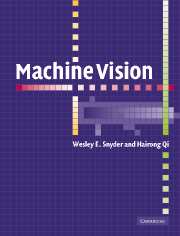Book contents
- Frontmatter
- Contents
- To the instructor
- Acknowledgements
- 1 Introduction
- 2 Review of mathematical principles
- 3 Writing programs to process images
- 4 Images: Formation and representation
- 5 Linear operators and kernels
- 6 Image relaxation: Restoration and feature extraction
- 7 Mathematical morphology
- 8 Segmentation
- 9 Shape
- 10 Consistent labeling
- 11 Parametric transforms
- 12 Graphs and graph-theoretic concepts
- 13 Image matching
- 14 Statistical pattern recognition
- 15 Clustering
- 16 Syntactic pattern recognition
- 17 Applications
- 18 Automatic target recognition
- Author index
- Index
To the instructor
Published online by Cambridge University Press: 05 June 2012
- Frontmatter
- Contents
- To the instructor
- Acknowledgements
- 1 Introduction
- 2 Review of mathematical principles
- 3 Writing programs to process images
- 4 Images: Formation and representation
- 5 Linear operators and kernels
- 6 Image relaxation: Restoration and feature extraction
- 7 Mathematical morphology
- 8 Segmentation
- 9 Shape
- 10 Consistent labeling
- 11 Parametric transforms
- 12 Graphs and graph-theoretic concepts
- 13 Image matching
- 14 Statistical pattern recognition
- 15 Clustering
- 16 Syntactic pattern recognition
- 17 Applications
- 18 Automatic target recognition
- Author index
- Index
Summary
This textbook covers both fundamentals and advanced topics in computer-based recognition of objects in scenes. It is intended to be both a text and a reference. Almost every chapter has a “Fundamentals” section which is pedagogically structured as a textbook, and a “Topics” section which includes extensive references to the current literature and can be used as a reference. The text is directed toward graduate students and advanced undergraduates in electrical and computer engineering, computer science, or mathematics.
Chapters 4 through 17 cover topics including edge detection, shape characterization, diffusion, adaptive contours, parametric transforms, matching, and consistent labeling. Syntactic and statistical pattern recognition and clustering are introduced. Two recurrent themes are used throughout these chapters: Consistency (a principal philosophical construct for solving machine vision problems) and optimization (the mathematical tool used to implement those methods). These two topics are so pervasive that we conclude each chapter by discussing how they have been reflected in the text. Chapter 18 uses one application area, automatic target recognition, to show how all the topics presented in the previous chapters can be integrated to solve real-world problems.
This text assumes a solid graduate or advanced-undergraduate background including linear algebra and advanced calculus. The student who successfully completes this course can design a wide variety of industrial, medical, and military machine vision systems. Software and data used in the book can be found at www.cambridge.org/9780521830461.
Information
- Type
- Chapter
- Information
- Machine Vision , pp. xv - xviiPublisher: Cambridge University PressPrint publication year: 2004
